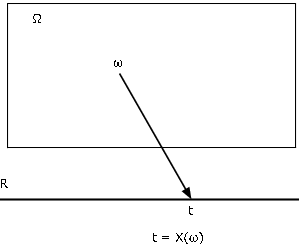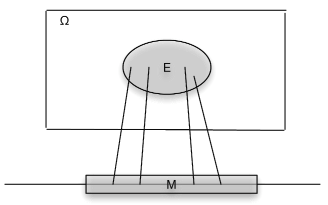| << Chapter < Page | Chapter >> Page > |
We consider in this chapter real random variables (i.e., real-valued random variables). In the chapter "Random Vectors and Joint Distributions" , we extend the notion to vector-valued random quantites. The fundamental idea of a real random variable is the assignment of a real number to each elementary outcome ω in the basic space Ω . Such an assignment amounts to determining a function X , whose domain is Ω and whose range is a subset of the real line R . Recall that a real-valued function on a domain (say an interval I on the real line) is characterized by the assignment of a real number y to each element x (argument) in the domain. For a real-valued function of a real variable, it is often possible to write a formula or otherwise state a rule describing the assignmentof the value to each argument. Except in special cases, we cannot write a formula for a random variable X . However, random variables share some important general properties offunctions which play an essential role in determining their usefulness.
Mappings and inverse mappings
There are various ways of characterizing a function. Probably the most useful for our purposes is as a mapping from the domain Ω to the codomain R . We find the mapping diagram of Figure 1 extremely useful in visualizing the essential patterns. Randomvariable X , as a mapping from basic space Ω to the real line R , assigns to each element ω a value . The object point ω is mapped, or carried, into the image point t . Each ω is mapped into exactly one t , although several ω may have the same image point.

Associated with a function X as a mapping are the inverse mapping and the inverse images it produces. Let M be a set of numbers on the real line. By the inverse image of M under the mapping X , we mean the set of all those which are mapped into M by X (see Figure 2). If X does not take a value in M , the inverse image is the empty set (impossible event). If M includes the range of X , (the set of all possible values of X ), the inverse image is the entire basic space Ω . Formally we write
Now we assume the set , a subset of Ω , is an event for each M . A detailed examination of that assertion is a topic in measure theory . Fortunately, the results of measure theory ensure that we may make the assumption for any X and any subset M of the real line likely to be encountered in practice. The set is the event that X takes a value in M . As an event, it may be assigned a probability.


Notification Switch
Would you like to follow the 'Applied probability' conversation and receive update notifications?